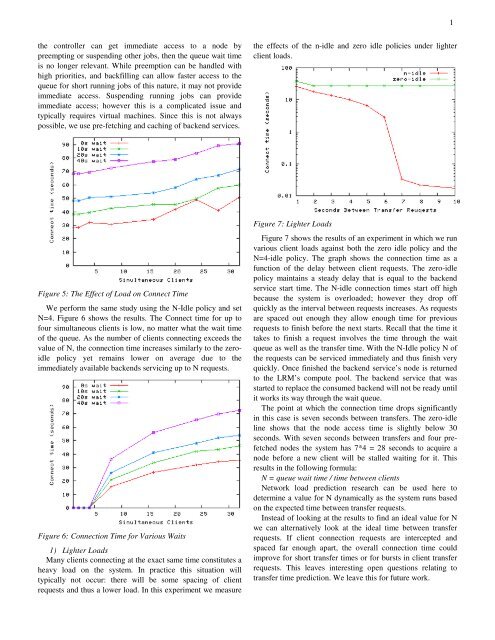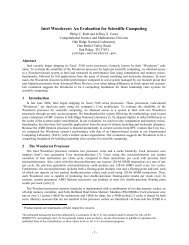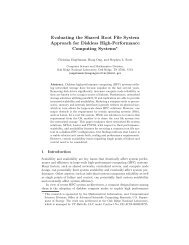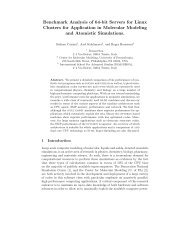An Architecture for Dynamic Allocation of Compute Cluster Bandwidth
An Architecture for Dynamic Allocation of Compute Cluster Bandwidth
An Architecture for Dynamic Allocation of Compute Cluster Bandwidth
Create successful ePaper yourself
Turn your PDF publications into a flip-book with our unique Google optimized e-Paper software.
1the controller can get immediate access to a node bypreempting or suspending other jobs, then the queue wait timeis no longer relevant. While preemption can be handled withhigh priorities, and backfilling can allow faster access to thequeue <strong>for</strong> short running jobs <strong>of</strong> this nature, it may not provideimmediate access. Suspending running jobs can provideimmediate access; however this is a complicated issue andtypically requires virtual machines. Since this is not alwayspossible, we use pre-fetching and caching <strong>of</strong> backend services.the effects <strong>of</strong> the n-idle and zero idle policies under lighterclient loads.Figure 5: The Effect <strong>of</strong> Load on Connect TimeWe per<strong>for</strong>m the same study using the N-Idle policy and setN=4. Figure 6 shows the results. The Connect time <strong>for</strong> up t<strong>of</strong>our simultaneous clients is low, no matter what the wait time<strong>of</strong> the queue. As the number <strong>of</strong> clients connecting exceeds thevalue <strong>of</strong> N, the connection time increases similarly to the zeroidlepolicy yet remains lower on average due to theimmediately available backends servicing up to N requests.Figure 6: Connection Time <strong>for</strong> Various Waits1) Lighter LoadsMany clients connecting at the exact same time constitutes aheavy load on the system. In practice this situation willtypically not occur: there will be some spacing <strong>of</strong> clientrequests and thus a lower load. In this experiment we measureFigure 7: Lighter LoadsFigure 7 shows the results <strong>of</strong> an experiment in which we runvarious client loads against both the zero idle policy and theN=4-idle policy. The graph shows the connection time as afunction <strong>of</strong> the delay between client requests. The zero-idlepolicy maintains a steady delay that is equal to the backendservice start time. The N-idle connection times start <strong>of</strong>f highbecause the system is overloaded; however they drop <strong>of</strong>fquickly as the interval between requests increases. As requestsare spaced out enough they allow enough time <strong>for</strong> previousrequests to finish be<strong>for</strong>e the next starts. Recall that the time ittakes to finish a request involves the time through the waitqueue as well as the transfer time. With the N-Idle policy N <strong>of</strong>the requests can be serviced immediately and thus finish veryquickly. Once finished the backend service’s node is returnedto the LRM’s compute pool. The backend service that wasstarted to replace the consumed backend will not be ready untilit works its way through the wait queue.The point at which the connection time drops significantlyin this case is seven seconds between transfers. The zero-idleline shows that the node access time is slightly below 30seconds. With seven seconds between transfers and four prefetchednodes the system has 7*4 = 28 seconds to acquire anode be<strong>for</strong>e a new client will be stalled waiting <strong>for</strong> it. Thisresults in the following <strong>for</strong>mula:N = queue wait time / time between clientsNetwork load prediction research can be used here todetermine a value <strong>for</strong> N dynamically as the system runs basedon the expected time between transfer requests.Instead <strong>of</strong> looking at the results to find an ideal value <strong>for</strong> Nwe can alternatively look at the ideal time between transferrequests. If client connection requests are intercepted andspaced far enough apart, the overall connection time couldimprove <strong>for</strong> short transfer times or <strong>for</strong> bursts in client transferrequests. This leaves interesting open questions relating totransfer time prediction. We leave this <strong>for</strong> future work.
















